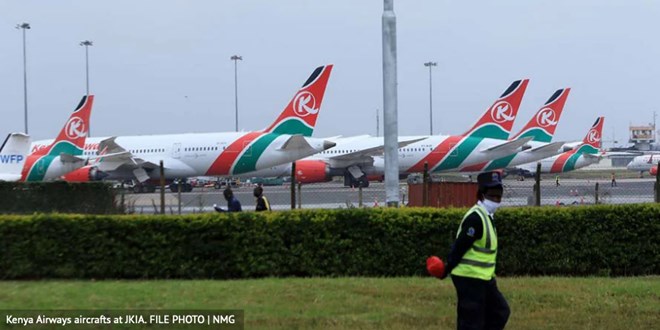
Tuesday August 25, 2020

Kenya Airways is seeking to lay off half of its pilots as it slashes costs to weather the cash flow crisis deepened by the Covid-19 pandemic.
The national carrier intends to cut up to 207 of its 414 pilot jobs, which account for nearly half of its payroll costs, over the next three years.
It expects to save nearly Sh3.24 billion if it meets the desired target of having between 207 and 248 pilots on its books.
KQ has so far laid off some 650 employees, mostly trainee pilots, trainee cabin crew, technician trainees and newly hired staff on probation, and plans to shed 590 more jobs.
The airline says that pilots account for 10 percent of the airline’s total workforce, but take home the equivalent of 45 per cent of the overall payout to employees or Sh6.48 billion based on the carrier’s wage bill for the year to December.This means that on average a KQ pilot costs the company Sh1.3 million, a payout that matches the salaries and allowances of top chief executives of State-owned firms such as KenGen Kenya-Re and Kenya Power.
KQ chief executive Allan Kilavuka told the Business Daily that the job cuts are based on revenue projections.
Global airlines cut their coronavirus recovery forecast on Tuesday, saying it would take until 2024 – a year longer than previously expected – for passenger traffic to return to pre-crisis levels.
“Based on our three-year projection, we will require 50 percent to 60 percent of pilots to efficiently support the reduced operations,” Mr Kilavuka said.
“Our target is to reduce the company’s overall total fixed costs, not just staff costs, by about 50 percent in response to our revenue projections.”
This suggests that KQ is seeking cost savings of up to Sh63 billion based on its expenses of Sh127 billion for the year to December.
“We are reducing our network, our assets, and our people. The reduction will not be like for like, meaning that the shrinkage will not be uniform across the three areas,” said Mr Kilavuka.
Employees protests over wages at the national carrier have in the past resulted in flight disruptions or paralysed services on some routes.
The airline has been involved in protracted court fights with its pilots and has also suffered from poaching of talent by wealthy Middle East carriers that can afford to pay higher wages, triggering a talent war that has made pilots among Kenya’s best paid workers.
The number of KQ pilots has dropped by 91 or 18 percent since 2014 when it dipped into losses after making costly aircraft purchases, which coincided with a slump in tourist and business travel to Kenya blamed on a spate of attacks by Al-Shabaab militants.
The airline’s fleet increased from 27 in 2010 to 45 in 2015 while pilots hiring rose in tandem from 240 in 2006 to a peak of 523 in 2015 on the back of an aggressive expansion plan.
This left KQ with mounting debts and heavier payroll costs as it struggled to return to profitability.
The pilots’ umbrella body, the Kenya Airline Pilots Association (Kalpa), has opposed the airline’s plans to shed jobs.
Employees in the Kenya Aviation Workers Union (KAWU) account for the majority of workforce at 65 percent but take home an estimated 30.5 percent of KQ’s payroll.
Managers at the airline are 22 percent of the workforce and draw compensation equivalent of 22 per cent of the payroll costs.
“We need to make the right decisions today for the sustainability of the business tomorrow, hence the decision to shrink now in order to grow in future and emerge on the other side of the crisis a leaner, more efficient airline,” Mr Kilavuka said.
The Covid-19 pandemic has depressed the global aviation industry, with African carriers alone expected to lose $6 billion (Sh648 billion) this year in revenue.
In an update on the crisis which has led to a collapse in travel demand, the International Air Transport Association (IATA) – the global airlines lobby – cited slow virus containment in the United States and developing countries, and a weaker outlook for corporate travel outlook.
But KQ was struggling long before the coronavirus outbreak, posting 2019 losses of almost Sh13 billion, from a loss of Sh7.5 billion in 2018.
It cut salaries by as much as 80 percent when the crisis started, and sought a government bailout to help it take care of running costs after it grounded its planes when Kenya stopped commercial passenger flights to curb the spread of the virus.
The government declined to bail it out, opting to press ahead with a pre-pandemic plan to nationalise the carrier, part of wider reforms in Kenya’s aviation sector.
The airline faces stiff competition, not just from major players like Emirates and Turkish Airlines. Both Uganda and Tanzania have poured cash into their flag carriers in the past three years, joining countries such as Rwanda and Togo which have also ramped up investment.
Ethiopian Airlines, however, is the biggest regional threat.